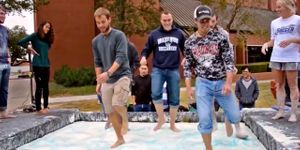While any surgery that aims to remove cancerous tumors is risky, there is an increased amount of risk and caution when it’s a brain tumor. Neurosurgeons and their OR teams must be incredibly careful when trying to remove tumors from the brain. Even benign tumors can cause damage to the surrounding brain tissue when removed. Then there is the problem of sending tissue to the lab to determine if it’s cancerous or benign. This can take hours and put the patient at further risk.

Lasers are the new way to test tumors during surgery
Image Credit: Wikimedia
A new way of going at this complex surgery might be on the horizon though. In London, a surgical team recently used lasers to check if brain tissue being removed was cancerous or benign. This kind of surgery and diagnostic technique was a first in Europe.
Lasers were used to bounce light off brain tissue and measure the reflection of that light as a way to tell if the tumor being removed was cancerous or healthy. When the brain is exposed during the operation, surgeons used a near infrared laser probe. This kind of probe has a beam of light that when directed at the brain tissues causes the molecules in the brain cells to, well, shake rattle and roll. The probe is equipped with fiber optics that catch all the light that is scattered around and bouncing off the tissue.
The patterns of vibrations and light are then analyzed with using Raman Spectroscopy, which can figure out the frequency of the vibrations. The vibrations that are caused by the laser are different depending on the type of tissue. Healthy tissue has a specific pattern of vibrations that are not the same as the patterns created by cancerous tissue.
In brain surgery the goal is always to remove as much cancerous tissue as possible without taking too much healthy tissue in the process. When healthy tissue is removed or compromised in brain surgery, the patient can suffer cognitive loss, diminished memory and speech impairment as well as damage to fine and gross motor skills.
Neurosurgeon Babar Vaqas, the trial chief investigator for this kind of surgery
told the BBC, "Optical technologies like this are the future. They are fast and don't destroy any tissue and could be used during many types of cancer surgery or when dealing with infection like a brain abscess."
This new approach is a significant improvement over conventional methods where multiple samples of brain tissue must be excised and checked for cancer. Each frozen section biopsy can take up to 40 minutes, lengthening the time the patient is in the operating room. It is hoped the technique could make this kind of delicate surgery faster and more accurate
The patient in this historic case is Reuben Hill, a 22 year-old PhD candidate at Imperial College in London. Ironically Mr. Hill works with the same kinds of lasers used in his ground-breaking surgery. Mr. Hill recovered at Charing Cross Hospital, part of the NHS Health Care Trust at Imperial College and the first hospital to try the laser technique. Mr. Hill is an avid singer with the Imperial College choir. Towards the end of his surgery he was woken from the anesthesia and asked to sing and speak as the last parts of the tumor were excised. This was to make sure the team was not removing healthy tissue that could negatively impact his speech.
The surgical team hopes to use the laser on 30 to 40 patients this year to gather more data on how it works and what the outcomes could be. Check out the video below to hear more about this new advance in neurosurgery.









